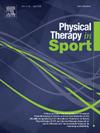探讨加权和非加权低剂量哥本哈根内收运动训练方案对髋关节内收和外展力量的影响:一项随机对照试验,对象为高级男性业余橄榄球联盟球员
IF 2.2
3区 医学
Q1 REHABILITATION
引用次数: 0
摘要
目的探讨等距加权哥本哈根内收(WCA)训练方案和等距非加权哥本哈根内收(CA)训练方案对髋关节内收力量、外展力量和内收外展力量比的影响。设计随机对照试验,结果结构平坦。设置橄榄球训练设施。参与者:31名男子橄榄球运动员。主要结局方法采用独立样本t检验评估髋关节内收强度、外展强度和内收:外展比的组间差异。采用配对样本t检验评估组内髋关节力量差异。结果CA组15例,WCA组16例。干预后,组间髋关节内收外展强度比差异有统计学意义(0.09 Nm/kg, p = 0.032),且效应量较大(ES = 0.812)。髋内收强度(0.21 Nm/kg, p = 0.058)和髋外展强度(0.01 Nm/kg, p = 0.856)组间差异无统计学意义。WCA组髋关节内收显著增加(0.22 N/kg, + 10%, p = 0.008),髋关节内收:外展比显著增加(0.06 N/kg, + 7%, p = 0.036),但髋关节外展没有显著增加(0.08 N/kg, + 4%, p = 0.055)。CA组未观察到髋部力量的显著变化。结论:与等长CA训练相比,低剂量8周内收肌训练方案使用等长WCA训练可显著增加髋关节内收:外展力量比。本文章由计算机程序翻译,如有差异,请以英文原文为准。
Exploring the effects of a weighted vs unweighted low-dose isometric Copenhagen adduction exercise training programme on hip adduction and abduction strength: a randomised controlled trial in senior-level male amateur rugby union players
Objectives
To explore the effect of an isometric weighted Copenhagen adduction (WCA) exercise programme and an isometric unweighted Copenhagen adduction (CA) exercise programme on hip adduction strength, abduction strength and adduction:abduction strength ratio.
Design
Randomized controlled trial, with flat outcome structure.
Setting
Rugby training facility.
Participants
Thirty-one male rugby players.
Main outcome methods
Between-group differences in hip adduction strength, abduction strength and adduction:abduction ratio were assessed using independent-sample t-tests. Within-group differences in hip strength were assessed using paired-sample t-tests.
Results
15 participants were assigned to the CA group and sixteen to the WCA group. Post-intervention, a significant between-group difference in hip adduction:abduction strength ratio was observed (0.09 Nm/kg, p = 0.032) with large effect size (ES = 0.812). No significant between-group differences were evident for hip adduction strength (0.21 Nm/kg, p = 0.058) or hip abduction strength (0.01 Nm/kg, p = 0.856). The WCA group demonstrated significant increases in hip adduction (0.22 N/kg, +10 %, p = 0.008) and hip adduction:abduction ratio (0.06 N/kg, +7 %, p = 0.036), but not hip abduction (0.08 N/kg, +4 %, p = 0.055), following the 8-week programme. No significant changes in hip strength were observed in the CA group.
Conclusions
A low-dose 8-week adductor exercise programme using the isometric WCA exercise elicits significant increases in hip adduction:abduction strength ratio when compared to an isometric CA exercise.
求助全文
通过发布文献求助,成功后即可免费获取论文全文。
去求助
来源期刊

Physical Therapy in Sport
医学-康复医学
CiteScore
4.50
自引率
8.30%
发文量
125
审稿时长
39 days
期刊介绍:
Physical Therapy in Sport is an international peer-reviewed journal that provides a forum for the publication of research and clinical practice material relevant to the healthcare professions involved in sports and exercise medicine, and rehabilitation. The journal publishes material that is indispensable for day-to-day practice and continuing professional development. Physical Therapy in Sport covers topics dealing with the diagnosis, treatment, and prevention of injuries, as well as more general areas of sports and exercise medicine and related sports science.
The journal publishes original research, case studies, reviews, masterclasses, papers on clinical approaches, and book reviews, as well as occasional reports from conferences. Papers are double-blind peer-reviewed by our international advisory board and other international experts, and submissions from a broad range of disciplines are actively encouraged.
 求助内容:
求助内容: 应助结果提醒方式:
应助结果提醒方式:


